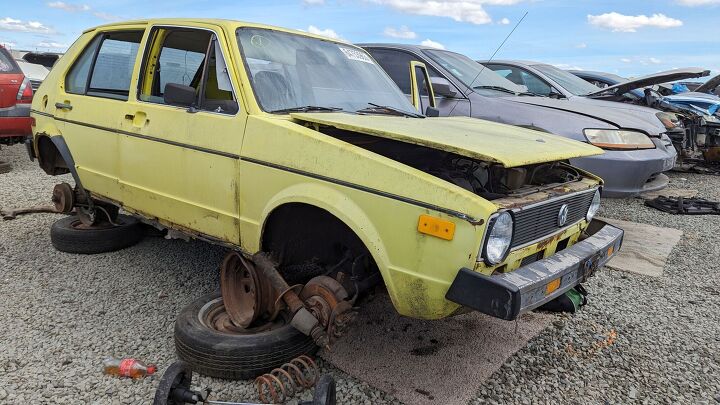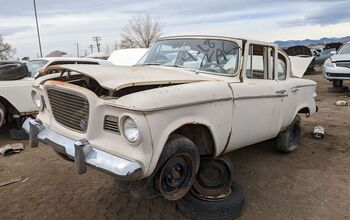Junkyard Find: 1975 Volkswagen Rabbit 4-Door

From the time of the first KdF-Wagens until distressingly deep into the 1970s, Volkswagens had air-cooled engines in back and rode on goofy 1930s chassis designs. Finally, the Audi 80-based Dasher showed up here as a 1974 model, but it wasn't until the following model year that the first true water-cooled VW went on sale in North America.
This was the 1975 Volkswagen Rabbit, known as the Golf back home (some claim the Golf-based Scirocco may have hit US showrooms a few days before the Rabbit; please discuss in comments). While new air-cooled Beetles remained available here through 1979, sales of those relics fell off a cliff while the revolutionary new hatchback became an instant sales hit on our continent.
Since I began documenting interesting discarded vehicles, 16 years ago, I'd been seeking a first-year Rabbit in car graveyards all over the country. The closest I'd come was a '77 two-door in Denver, but then I hit pay dirt in a Northern California yard last week. Behold the November 1974 date of manufacture on the build sticker!
This yard also has an early Peugeot 505 Turbodiesel, an Oldsmobile Toronado Troféo and even an example of the long-forgotten VW Jetta Hybrid. It was a productive stop on my NorCal Fall Junkyard Tour.
The main reason it's so tough to find a 1975 Rabbit in the boneyards these days is the eagerness with which these cars dissolved into heaps of red powder. Even in not-so-rusty California, they tended to rot in any location that winter rainwater could collect.
It wouldn't have been a challenge to find a '75 Rabbit in California wrecking yards during the 1980s and 1990s, of course. Plenty were sold in the Golden State.
This one has many years of leaf mulch built up in the usual spots, so it's likely that it stopped being driven decades ago and sat in a driveway or yard until everyone got tired of looking at it. That's when Pick-n-Pull got the call to drag it away.
This car came with a 1.5-liter carbureted engine rated at 70 horsepower and 81 foot-pounds.
Yes, that's a points distributor. Futuristic electronic fuel-delivery and ignition hardware came a bit later for the Rabbit. For 1976, the Rabbit got a 1.6-liter engine with one apiece additional horse and pound-foot. With a car weighing just 1,827 pounds, that power upgrade helped.
At least this one has front disc brakes; supposedly, some of the early base-model 1975 Rabbits came with four-wheel-drums.
The 1975 Rabbit was available with two or four doors, in base, Custom or Deluxe trim levels.
MSRP for the four-door started at $3,139, or about $18,498 in 2023 dollars. Meanwhile, your friendly American VW dealership would sell you a shiny new Beetle for $2,895 ($17,060 today) or a Super Beetle for $3,095 ($18,239 now).
The price went up 250 bucks ($1,473 after inflation) if you insisted on an automatic transmission in your 1975 Rabbit. This one has the four-speed manual.
The factory idiot lights must have been insufficient for one of this car's early owners, because these aftermarket gauges have been installed.
The vacuum gauge makes some sense for drivers who needed a reminder to keep a light foot on the throttle to save gas during the 1979 Oil Crisis, but why risk the danger of a fuel line in the passenger compartment in order to have a fuel-pressure gauge on a carbureted engine? The junkyard always offers such mysteries for its visitors.
Was it worth restoring? Absolutely not.
Still, local owners of early Mk1 Golfs will be happy about the parts bonanza offered by this car, and I was happy with the historical bonanza (especially so soon after discovering a nearly-as-rare first-year Nissan Altima).
Zero to 50 in a snappy 8.2 seconds. Happy days are here again!
It beat eight other "super economy cars" and not by a hair, according to Road & Track.
This '75 Scirocco commercial was a lot more fun than the ones for its Rabbit cousin, so let's watch it.
[Images: The author]
Become a TTAC insider. Get the latest news, features, TTAC takes, and everything else that gets to the truth about cars first by subscribing to our newsletter.

Murilee Martin is the pen name of Phil Greden, a writer who has lived in Minnesota, California, Georgia and (now) Colorado. He has toiled at copywriting, technical writing, junkmail writing, fiction writing and now automotive writing. He has owned many terrible vehicles and some good ones. He spends a great deal of time in self-service junkyards. These days, he writes for publications including Autoweek, Autoblog, Hagerty, The Truth About Cars and Capital One.
More by Murilee Martin
Latest Car Reviews
Read moreLatest Product Reviews
Read moreRecent Comments
- Mike-NB2 This is a mostly uninformed vote, but I'll go with the Mazda 3 too.I haven't driven a new Civic, so I can't say anything about it, but two weeks ago I had a 2023 Corolla as a rental. While I can understand why so many people buy these, I was surprised at how bad the CVT is. Many rentals I've driven have a CVT and while I know it has one and can tell, they aren't usually too bad. I'd never own a car with a CVT, but I can live with one as a rental. But the Corolla's CVT was terrible. It was like it screamed "CVT!" the whole time. On the highway with cruise control on, I could feel it adjusting to track the set speed. Passing on the highway (two-lane) was risky. The engine isn't under-powered, but the CVT makes it seem that way.A minor complaint is about the steering. It's waaaay over-assisted. At low speeds, it's like a 70s LTD with one-finger effort. Maybe that's deliberate though, given the Corolla's demographic.
- Mike-NB2 2019 Ranger - 30,000 miles / 50,000 km. Nothing but oil changes. Original tires are being replaced a week from Wednesday. (Not all that mileage is on the original A/S tires. I put dedicated winter rims/tires on it every winter.)2024 - Golf R - 1700 miles / 2800 km. Not really broken in yet. Nothing but gas in the tank.
- SaulTigh I've got a 2014 F150 with 87K on the clock and have spent exactly $4,180.77 in maintenance and repairs in that time. That's pretty hard to beat.Hard to say on my 2019 Mercedes, because I prepaid for three years of service (B,A,B) and am getting the last of those at the end of the month. Did just drop $1,700 on new Michelins for it at Tire Rack. Tires for the F150 late last year were under $700, so I'd say the Benz is roughly 2 to 3 times as pricy for anything over the Ford.I have the F150 serviced at a large independent shop, the Benz at the dealership.
- Bike Rather have a union negotiating my pay rises with inflation at the moment.
- Bike Poor Redapple won't be sitting down for a while after opening that can of Whiparse

















































Comments
Join the conversation
My mother owned a 1979 (Bought in Dec '78) VW Rabbit GL Tan on Tan vinyl, made in Pennsylvania. First of a new generation with fuel injection, electric cooling fans and a 3 speed Automatic. We traveled all over the place in it. We had electrical gremlins in it. It had a gift of snapping the accelerator cable multiple times. Fuel economy stunk for such a small car. We parted ways in July 1991. Super sad moment.
VW was an early adopter of Fuel injection. The Bosch K Jetronic made them quick, economical, but especially more drivable than much of the competition. Interestingly, VW stayed with points and condensers until 1981 when they started using a Hall sending unit eliminating points.